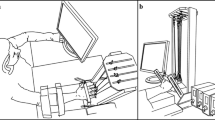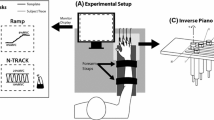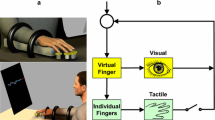Abstract
The purpose of the study was to explore the ability of the central nervous system (CNS) to organize synergies at two levels of a hypothetical control hierarchy involved in two-hand, multi-finger tasks. We investigated indices (ΔV) of finger force co-variation across trials as reflections of synergies stabilizing the total force (F TOT). Subjects produced constant force with one or two finger-pairs (from one hand or two hands). In trials starting with one finger-pair, subjects added another finger-pair without changing F TOT. In trials starting with two finger-pairs, subjects removed one of the finger-pairs without changing F TOT. Adding or removing a finger-pair resulted in a transient drop in ΔV computed for the finger-pair that remained active throughout the trial. This drop in ΔV was seen simultaneously with force changes. Compared to the original steady-state, addition of a finger-pair led to a significant drop in ΔV at the newly established steady-state. This drop eliminated negative co-variation among finger forces that had stabilized F TOT. In contrast, in trials starting with two finger-pairs, no negative co-variation between finger forces within-a-pair was seen. Removing a finger-pair led to the emergence of negative co-variation between finger forces at the new steady-state. The ΔV index computed across two finger-pairs confirmed the existence of negative force co-variation. The emergence and disappearance of force stabilizing synergies within a finger-pair may signal limitations in the ability of the CNS in forming synergies at two different hierarchical levels.





Similar content being viewed by others
References
Arbib MA, Iberall T, Lyons D (1985) Coordinated control programs for movements of the hand. Exp Brain Res Suppl 10:111–129
Baud-Bovy G, Soechting JF (2001) Two virtual fingers in the control of the tripod grasp. J Neurophysiol 86:604–615
Bernstein NA (1947) On the construction of movements. Medgiz, Moscow [in Russian]
Bernstein NA (1967) The co-ordination and regulation of movements. Pergamon Press, Oxford
Bernstein NA (1996) On dexterity and its development. In: Latash ML, Turvey MT (eds) Dexterity and its development. Erlbaum, Mahwah
Carson RG (1995) The dynamics of isometric bimanual coordination. Exp Brain Res 105:465–476
Cincotta M, Borgheresi A, Balestrieri G, Giovannelli F, Rossi S, Ragazzoni A, Zaccara G, Ziemann U (2004) Involvement of the human dorsal premotor cortex in unimanual motor control: an interference approach using transcranial magnetic stimulation. Neurosci Lett 367:189–193
Deiber MP, Honda M, Ibanez V, Sadato N, Hallett M (1999) Mesial motor areas in self-initiated versus externally triggered movements examined with fMRI: effect of movement type and rate. J Neurophysiol 81:3065–3077
DeWeerd P, Reinke K, Ryan L, McIsaac T, Perschler P, Schnyer D, Trouard T, Gmitro A (2003) Cortical mechanisms for acquisition and performance of bimanual motor sequences. Neuroimage 19:1405–1416
Ferrand L, Jaric S (2006) Force coordination in static bimanual manipulation: effect of handedness. Motor Control 10(4):359–370
Gao F, Latash ML, Zatsiorsky VM (2005) Control of finger force direction in the flexion-extension plane. Exp Brain Res 161:307–315
Gelfand IM, Latash ML (1998) On the problem of adequate language in motor control. Motor Control 2:306–313
Gelfand IM, Tsetlin ML (1966) Mathematical modeling of the mechanisms of the central nervous system. In Gelfand et al (eds) Models of the structural-functional organization of certain biological systems. Nauka, Moscow, pp 1–22 (a translation is available in 1971 edition by MIT Press, Cambridge)
Goodman SR, Shim JK, Zatsiorsky VM, Latash ML (2005) Motor variability within a multi-effector system: experimental and analytical studies of multi-finger production of quick force pulses. Exp Brain Res 163:75–85
Gorniak SL, Zatsiorsky VM, Latash ML (2007) Hierarchies of synergies: an example of two-hand multi-finger tasks. Exp Brain Res 179(2):167–180
Haslinger B, Erhard P, Altenmueller E, Hennenlotter A, Schwaiger M, Graefin von Einsiedel H, Rummeny E, Conrad B, Celallos-Baumann AO (2004) Reduced recruitment of motor association areas during bimanual coordination in concert pianists. Hum Brain Mapp 22:206–215
Jancke L, Shah NJ, Peters M (2000) Cortical activations in primary and secondary motor areas for complex bimanual movements in professional pianists. Brain Res Cogn Brain Res 10:177–183
Jaric S, Collins JJ, Marwaha R, Russell E (2006) Interlimb and within limb force coordination in static bimanual manipulations task. Exp Brain Res 168(1–2):88–97
Jeannerod M, Arbib MA, Rizzolato G, Sakata H (1995) Grasping objects: the cortical mechanisms of visuomotor transformation. Trends Neurosci 18:314–320
Kandel ER, Schwartz JH, Jessell TM (eds) (2000) Principles of neural science, 4th edn. McGraw-Hill, New York
Kang N, Shinohara M, Zatsiorsky VM, Latash ML (2004) Learning multi-finger synergies: an uncontrolled manifold analysis. Exp Brain Res 157:336–350
Kermadi I, Liu Y, Roullier EM (2000) Do bimanual motor actions involve the dorsal premotor (PMd), cingulated (CMA) and posterior parietal (PPC) cortices? Comparison with primary and supplementary motor areas. Somatosens Mot Res 17(3):255–271
Kilbreath SL, Gandevia SC (1994) Limited independent flexion of the thumb and fingers in human subjects. J Physiol 479:487–497
Kim SW, Shim JK, Zatsiorsky VM, Latash ML (2006) Anticipatory adjustments of multi-finger synergies in preparation for self-triggered perturbations. Exp Brain Res 174:604–612
Latash ML (1996) How does our brain make its choices? In: Latash ML, Turvey MT (eds) Dexterity and its development. Erlbaum, Mahwah, pp 277–304
Latash ML (1998) Neurophysiological basis of movement, 1st edn. Human Kinetics, Champaign
Latash ML, Scholz JP, Danion F, Schöner G (2001) Structure of motor variability in marginally redundant multifinger force production tasks. Exp Brain Res 141:153–165
Latash ML, Scholz JP, Danion F, Schöner G (2002a) Finger coordination during discrete and oscillatory force production tasks. Exp Brain Res 146:412–432
Latash ML, Scholz JP, Schöner G (2002b) Motor control strategies revealed in the structure of motor variability. Exerc Sport Sci Rev 30:26–31
Latash ML, Yarrow K, Rothwell JC (2003) Changes in finger coordination and responses to single pulse TMS of motor cortex during practice of a multifinger force production task. Exp Brain Res 151:60–71
Latash ML, Scholz JP, Schöner G (2007) Toward a new theory of motor synergies. Motor Control 11:275–307
Li ZM, Latash ML, Zatsiorsky VM (1998) Force sharing among fingers as a model of the redundancy problem. Exp Brain Res 119:276–286
Li ZM, Zatsiorsky VM, Li S, Danion F, Latash ML (2001) Bilateral multifinger deficits in symmetric key-pressing tasks. Exp Brain Res 140:86–94
Li S, Danion F, Zatsiorsky VM, Latash ML (2002) Coupling phenomena during asynchronous submaximal two-hand, multi-finger production tasks in humans. Neurosci Lett 331:75–78
Loève M (1955) Probability theory. Van Nostrand, New York
MacKenzie CL, Iberall T (1994) The grasping hand. North Holland, Amsterdam
Nair DG, Purcott KL, Fuchs A, Steinberg F, Kelso JAS (2003) Cortical and cerebellar activity of the human brain during imagined and executed unimanual and bimanual action sequences: a functional MRI study. Cogn Brain Res 15:250–260
Olafsdottir H, Yoshida N, Zatsiorsky VM, Latash ML (2007) Elderly show decreased adjustments of motor synergies in preparation to action. Clin Biomech 22:44–51
Pollok B, Suedmeyer M, Gross J, Schnitzler A (2005) The oscillatory network of simple repetitive bimanual movements. Cogn Brain Res 25:300–311
Prilutsky BI, Zatsiorsky VM (2002) Optimization-based models of muscle coordination. Exerc Sport Sci Rev 30:32–38
Reilly KT, Schieber MH (2003) Incomplete functional subdivision of the human multitendoned finger muscle flexor digitorum profundus: an electromyographic study. J Neurophysiol 90:2560–2570
Santello M, Fuglevand AJ (2004) Role of across-muscle motor unit synchrony for the coordination of forces. Exp Brain Res 159:501–508
Santello M, Soechting JF (2000) Force synergies for multifingered grasping. Exp Brain Res 133:457–467
Schieber MH (1990) How might the motor cortex individuate movements? Trends Neurosci 13:440–445
Schieber MH (2002) Motor cortex and the distributed anatomy of finger movements. Adv Exp Med Biol 508:411–416
Schieber MH, Gardinier J, Liu J (2001) Tension distribution to the five digits of the hand by neuromuscular compartments in the macaque flexor digitorum profundus. J Neurosci 21:2150–2158
Schieber MH, Hibbard LS (1993) How somatotopic is the motor cortex hand area? Science 261:489–492
Schieber MH, Santello M (2004) Hand function: peripheral and central constraints on performance. J Appl Physiol 96:2293–2300
Scholz JP, Danion F, Latash ML, Schöner G (2002) Understanding finger coordination through analysis of the structure of force variability. Biol Cybern 86:29–39
Serrien DJ, Strens LHA, Oliviero A, Brown P (2002) Repetitive transcranial magnetic stimulation of the supplementary motor area (SMA) degrades bimanual movement control in humans. Neurosci Lett 328:89–92
Shim JK, Latash ML, Zatsiorsky VM (2003) The human central nervous system needs time to organize task-specific covariation of finger forces. Neurosci Lett 353:72–74
Shim JK, Latash ML, Zatsiorsky VM (2005a) Prehension synergies in three dimensions. J Neurophysiol 93:766–776
Shim JK, Olafsdottir H, Zatsiorsky VM, Latash ML (2005b) The emergence and disappearance of multi-digit synergies during force-production tasks. Exp Brain Res 164:260–270
Turvey MT (1990) Coordination. Am Psychol 45(8):938–953
Vereijken B, Whiting HT, Beek WJ (1992) A dynamical systems approach to skill acquisition. Q J Exp Psychol A 45(2):323–344
von Schroeder HP, Botte MJ (1993) The functional significance of the long extensors and juncturae tendinum in finger extension. J Hand Surg 18:641–647
Winges SA, Johnston JA, Santello M (2006) Muscle-pair specific distribution and grip-type modulation of neural common input to extrinsic digit flexors. J Neurophysiol 96:1258–1266
Zatsiorsky VM, Latash ML (2004) Prehension synergies. Exerc Sport Sci Rev 32:75–80
Zatsiorsky VM, Li ZM, Latash ML (2000) Enslaving effects in multi-finger force production. Exp Brain Res 131:187–195
Zatsiorsky VM, Gregory RW, Latash ML (2002) Force and torque production in static multi-finger prehension: biomechanics and control. Part II. Control. Biol Cybern 87:40–49
Zatsiorsky VM, Gao F, Latash ML (2003) Finger force vectors in multi-finger prehension. J Biomech 36:1745–1749
Acknowledgment
The study was in part supported by NIH grants AG-018751, NS-035032, and AR-048563.
Author information
Authors and Affiliations
Corresponding author
Rights and permissions
About this article
Cite this article
Gorniak, S.L., Zatsiorsky, V.M. & Latash, M.L. Emerging and disappearing synergies in a hierarchically controlled system. Exp Brain Res 183, 259–270 (2007). https://doi.org/10.1007/s00221-007-1042-9
Received:
Accepted:
Published:
Issue Date:
DOI: https://doi.org/10.1007/s00221-007-1042-9




